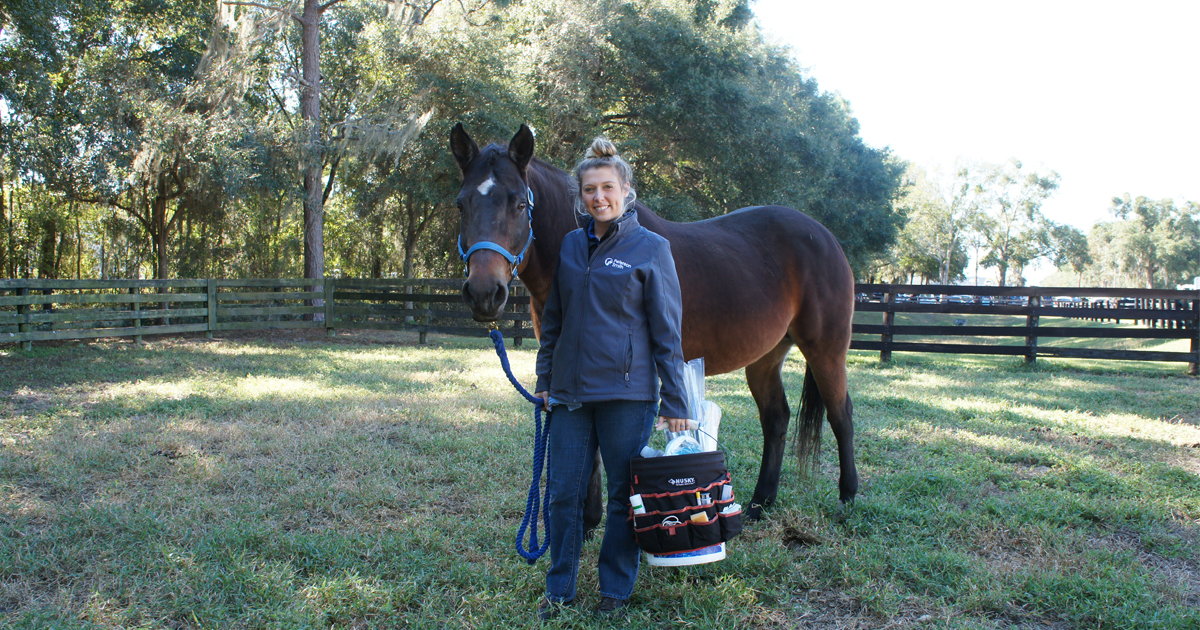Written by Dr. Jordan Lopez
2021-2022 Peterson Smith Equine Hospital + Complete Care Ambulatory Intern
What is a problem mare?
A “problem mare” refers to a mare that:
- Fails to conceive a pregnancy after multiple breedings
- Cannot carry a pregnancy to term
- Has known reproductive pathology
- Has behavioral issues that impact reproduction
The most common causes of infertility in these mares is poor breeding management, conformational defects and reproductive pathology. While breeding management and conformational defects can be more easily managed, reproductive pathology is more challenging to both diagnose and treat accordingly.
Diagnosing the Problem
A full Breeding Soundness Examination (BSE) is recommended for problem mares. This series of testing will allow for diagnosis of the problem, development of a treatment plan and determination of prognosis for future fertility. There are four main defenses against contamination of the reproductive tract that prevent endometritis (uterine infection). The vulva and cervix act as a physical barrier while uterine contractions and lymphatic drainage aid in uterine clearance.
A BSE includes:
- Reproductive history
- Physical examination
- Vaginal speculum and cervical palpation
- Transrectal palpation and ultrasound
- Uterine culture and cytology
- Uterine biopsy

A detailed history should be obtained and includes the mares age, number of previous breedings, last breeding date, last foaling date, type of breeding, number of stallions she was bred to and any known systemic or reproductive abnormalities. This will not only help determine if breeding management is an issue but will help direct the remainder of the BSE.
A physical examination will allow for identification of external conformational/anatomical defects. The most common of which is incorrect orientation between the vagina and rectum (poor perineal conformation) (Figure 1). This can increase the risk of ascending bacterial infections secondary to fecal contamination. A vaginal speculum exam and cervical palpation will also allow for detection of internal defects such as adhesions, laceration or pooling of urine in the vagina and possibly the uterus.

Transrectal palpation and ultrasound is used to detect other abnormalities that are present within the uterus and ovaries. A sample from the uterine lumen will also be collected for culture and cytology. A culture is used to determine if bacterial or other pathogens such as fungus are present in the uterus, while cytology looks for the presence of inflammatory cells (such a neutrophils) (Figure 2). These samples can be collected by a lavage, culture swab, cytology brush or uterine biopsy. A uterine biopsy, while more invasive, does collect an intact piece of the uterus that can be used to give a prognosis of future fertility.
Treatment Options
Prior to initiating any treatments, it is important to assure that any breeding management issues are addressed properly. Breeding should be performed as close to ovulation as possible, and this can be accomplished by periodic transrectal palpation and ultrasonography and using ovulatory agents. Problem mares should only be inseminated with good-quality semen within an appropriate time frame given the type of semen. Uterine lavage may also be warranted prior to and after breeding and will be discussed below. If a mare’s perineal conformation is determined to be the cause of subfertility and uterine contamination, a caslick’s procedure should be performed. This procedure involves suturing the upper aspect of the vulva closed to decrease the risk of contamination of the upper reproductive tract.
If the BSE results are consistent with endometritis, uterine treatment will be necessary. Although there is no single treatment regime that works for all mares, uterine lavage and ecbolic agents (medications that cause uterine contraction) are recommended as initial treatment. Uterine lavage involves infusing fluid into the uterus to flush out any contaminants and dead sperm. Antibiotics and other non-traditional agents can be infused into the uterus if a uterine infection has been diagnosed. Lavage can also be used prior to and after breeding to reduce the likelihood of sperm induced inflammation. Ecbolic agents, such as oxytocin and prostaglandins, induce contraction of the uterus to aid in fluid removal. These agents should be used in conjunction with lavage to assure all fluid is completely removed from the uterus.
Most mares can be managed with the traditional diagnostics and treatments discussed above. Advanced diagnostics such as hysteroscopy, oviduct evaluation and karyotyping may be warranted for more complex cases.
Resources
Samper, J. C. (2008). Breeding the Problem Mare by Artificial Insemination. AAEP proceedings, 54, 408–413. https://aaep.org/sites/default/files/issues/proceedings-08proceedings-z9100108000408.PDF.
Dascanio, J., McCue, P. (2014). Reproductive Evaluation of the Mare. Equine Reproductive Procedures, 1, 3-5. doi: 10.1002/9781118904398.
Uterine Culture, Cytology & Biopsy, Hysteroscopy. Uterine culture, cytology & biopsy. (n.d.). Retrieved October 28, 2021, from http://www.ansci.wisc.edu/jjp1/equine/lab/mare_exam/culture.htm.


